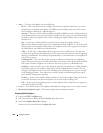
Configuring IPv6 595
OSPFv3 Interface Configuration
Use the OSPFv3 Interface Configuration
page to create and configure OSPFv3 interfaces. This page has
been updated to include the Passive Mode field.
To display the page, click IPv6 > OSPFv3 > Interface Configuration in the tree view.
Figure 10-23. OSPFv3 Interface Configuration
The OSPFv3 Interface Configuration page contains the following fields:
•
Interface
— Select the interface for which data is to be displayed or configured.
•
IPv6 Address
— The IPv6 address of the interface.
•
OSPFv3 Admin Mode
— You may select Enable or Disable from the drop-down menu. The default
value is Disable. You can configure OSPFv3 parameters without enabling OSPFv3 Admin Mode, but
they have no effect until you enable Admin Mode. The following information is displayed only if the
Admin Mode is enabled: State, Designated Router, Backup Designated Router, Number of Link
Events, LSA Ack Interval, and Metric Cost. For OSPFv3 to be fully functional, the interface must have
a valid IPv6 Prefix/Prefix Length. This can be done through the CLI using the
ipv6 address
command in the interface configuration mode.
NOTE: Once OSPFv3 is initialized on the router, it remains initialized until the router is reset.
•
OSPFv3 Area ID
— Enter the 32-bit integer in dotted decimal format that uniquely identifies the
OSPFv3 area to which the selected router interface connects. If you assign an Area ID which does not
exist, the area is created with default values.


















